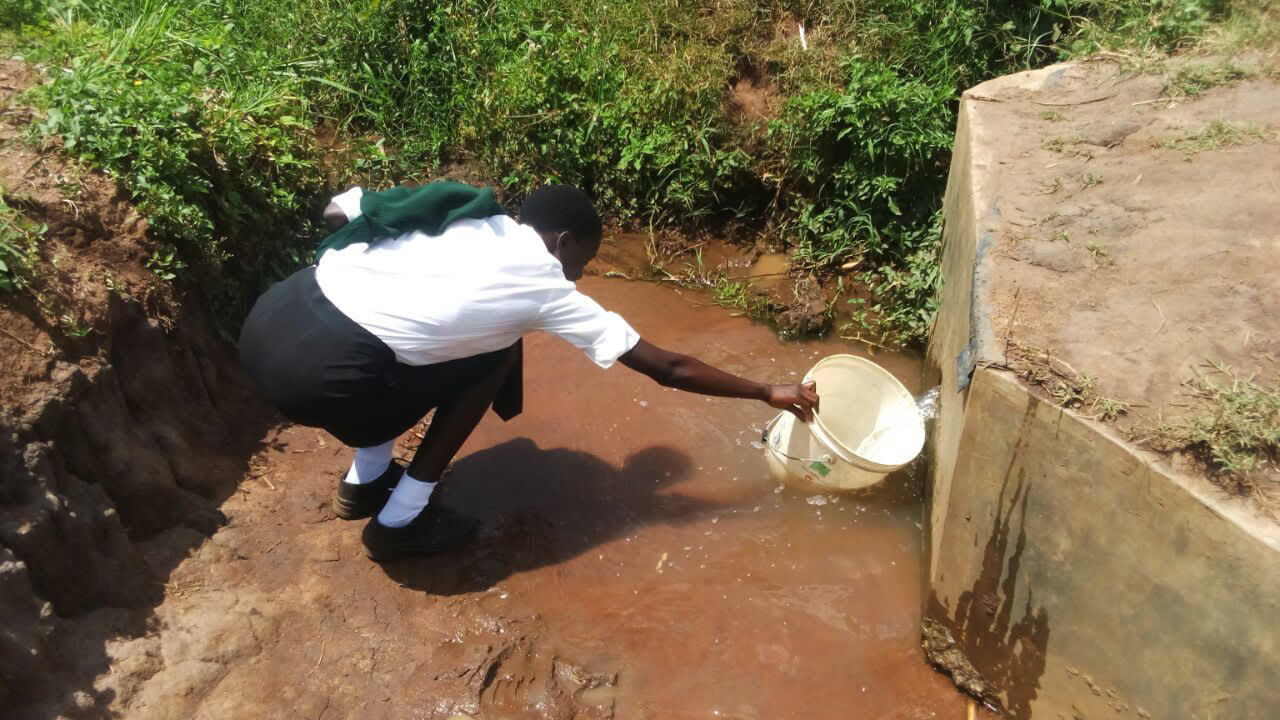This project is a part of our shared program with Western Water And Sanitation Forum (WEWASAFO). Our team is pleased to directly share the below report (edited for clarity, as needed).
Welcome to the School
A normal day at St. Kizito Lusumu Secondary School begins at 4am when the boarders wake up and prepare themselves for the day. They must arrive at the dining hall at 5:30am for a cup of porridge. The day scholars join them at 6:20am to eat porridge too. From 6:45 to 7:15 am the students do different cleaning chores depending on their grade. Regular classes start at 8am.
The school teaches a total of 710 students and employs 32 teachers. They also employ two cooks to prepare porridge for the students.
Water Situation
There are several students who live in the school dormitories and need water 24/7, but they suffer because the school does not have sufficient water. Another organization drilled a borehole which was fitted with a submersible pump. This electric pump was supposed to fill a tank that distributed water around school grounds, but did not work as intended. Moreover, it was expected that there are quality issues because of the dirt that is often mixed with the water. We as an organization do not work with submersible pumps simply because there is no supply chain in this area.
When the borehole fails to serve them, students have to walk two kilometers to the nearest water source to fetch drinking and cooking water as well as bathe. After drinking this water, students suffer from waterborne diseases.
The school needs a water source on campus that is both clean and reliable.
Sanitation Situation
St. Kizito Lusumu Secondary School only has pour flush toilets. Without water to run these, they are in a bit of a bind. During dry seasons, pump breakdowns, and electrical outages, these toilets become a sanitation nightmare. When the submersible is working, any and all taps can be used to wash hands. However, there are no other hand-washing stations for students to use when the taps are down.
And without a reliable water source on school grounds, the cleanliness of facilities is not reliable either. Teacher Francis Twoli said, "The health situation of the school is not good, many cases have been reported of absenteeism due to stomachaches which could be arising from unsafe water. The girls have had cases of candidiasis which is as a result of dirty toilets and overstaying with sanitary towels."
Plans: Hygiene and Sanitation Training and Hand-Washing Stations
Training will be held for two days. The facilitator will use PHAST (participatory hygiene and sanitation transformation), ABCD (asset-based community development), CTC (child to child), lectures, group discussions, and handouts to teach health topics and ways to promote good practices within the school. The CTC method will prepare students to lead other students into healthy habits, as well as kickstart a CTC club for the school. This CTC club will oversee the new facilities, such as hand-washing stations, and make sure they are kept clean and in working condition. The two hand-washing stations will be delivered to the school, and the club will fill them with water on a daily basis and make sure there is always a cleaning agent such as soap or ash.
Plans: Rainwater Catchment Tank
A 50,000-liter rainwater catchment tank will be constructed on school grounds. Teachers, students, and parents will gather the materials needed for this project, including sand, ballast, bricks, and hardcore. This contribution will fuel a sense of responsibility for the school and community to take care of their new facilities. Once materials are mobilized, the WEWASAFO team will arrive to lead the construction effort.
With adequate clean water, the school will have water for drinking, cooking, cleaning, and hand-washing.
Plans: VIP Latrines
Two triple-door latrines will be constructed, providing three new latrines for each gender. Latrine materials will be mobilized the same way as the tank, ensuring the school feels these facilities are truly theirs. And with a rainwater catchment tank nearby, there will be enough water to keep them clean.
School administration and parents are positive that with these new facilities and training, their students’ academic performance will improve. Students will be healthy and empowered to focus on what’s important! The principal is so excited about this project; he's already worked with parents and students to collect all of the local materials needed for tank and latrine construction. St. Kizito Lusumu is sponsored by the neighboring catholic church, which is also very excited about the project. A few church members came over when we were visiting to thank us for coming, and to pray blessings over the entire project and its donors.

 Rainwater Catchment
Rainwater Catchment
 Rehabilitation Project
Rehabilitation Project






























